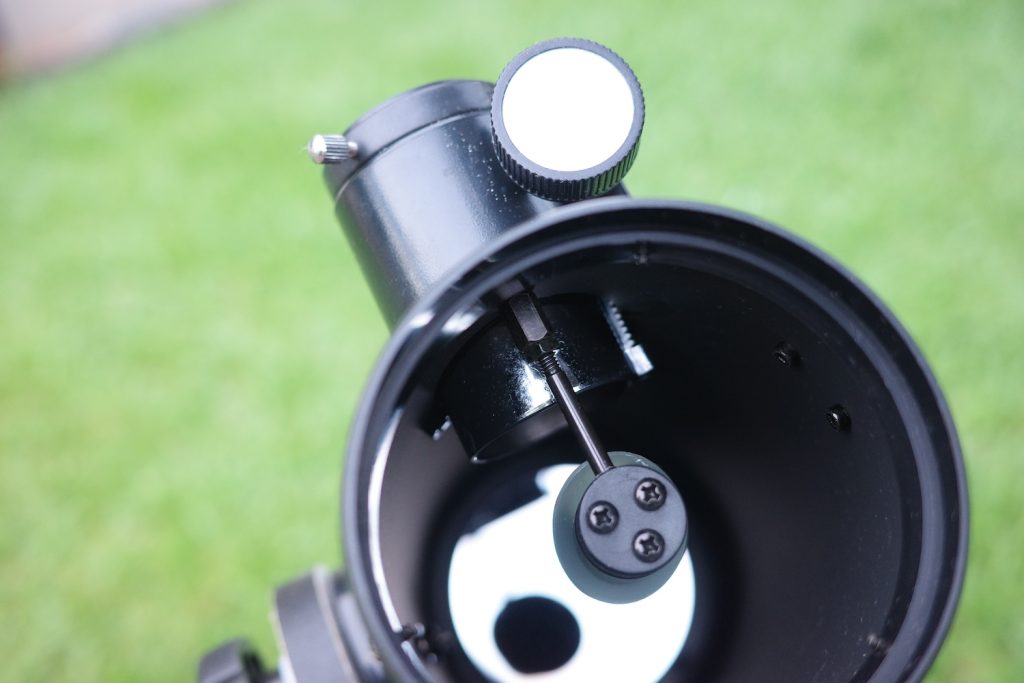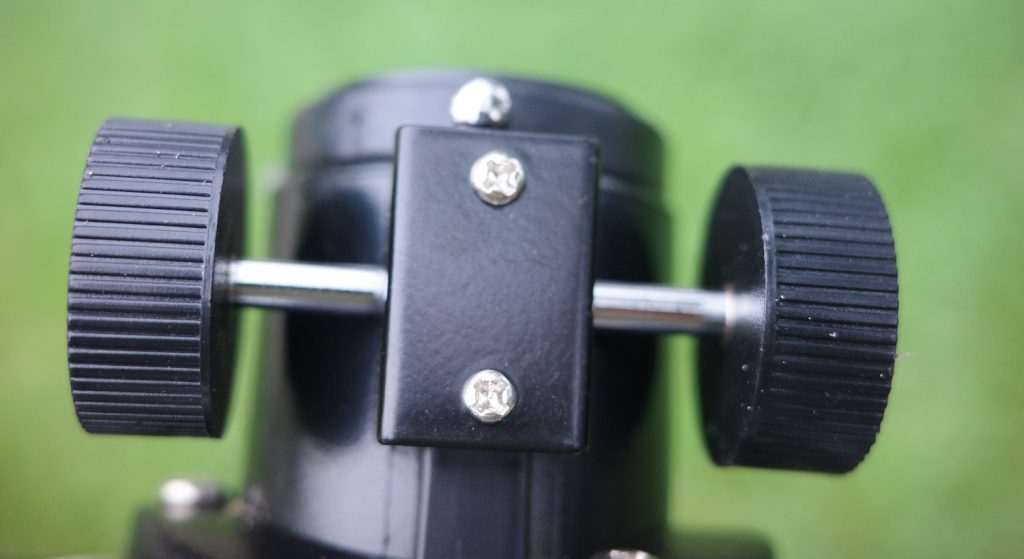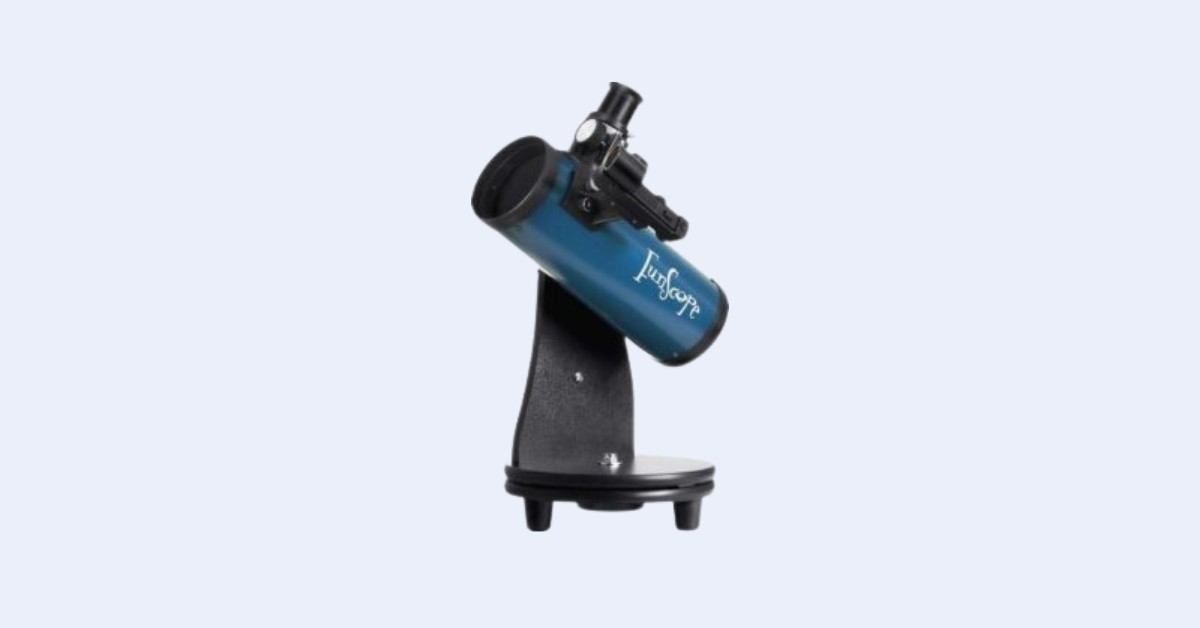The FunScope Optical Tube

The FunScope is a 76mm (3”) f/4 Newtonian reflector. A reflector is one of the most common types of telescopes I’ve seen being used for visual observing by new astronomers. Reflectors use two mirrors to gather and reflect the light from celestial objects into the eyepiece. The 76 mm-diameter primary mirror of the Funscope offers a lot of light-gathering potential.
Because it’s easier and cheaper to manufacture a mirror than a lens, owners of Newtonians, or “Newts,” as they’re often called, are able to afford a scope that gives them much brighter and more detailed views for far less money than a traditional refractor telescope of similar aperture would cost.
But the scope is very basic, and because of this, it does not feature some of the things we’d get on other higher-end telescopes.
Unlike most quality Newtonian reflectors, which have parabolic primary mirrors enabling them to properly focus light, the FunScope has a spherical primary mirror. This means that the mirror cannot focus light to a precise point, and the scope consequently delivers fuzzy images at any magnification above around 40x. A good 3” telescope should be usable at up to around 100x, with 60x or more being preferable for observing the Moon and planets. Unfortunately, the spherical primary mirror is simply a concession made to keep the FunScope as cheap as it is.
So too is the inability to collimate the primary mirror to ensure the sharpest possible images. If your FunScope arrives out of collimation, you either have to send it back, attempt to adjust it yourself by taking apart the scope, or just use it with even mushier images as-is.

Orion has outfitted the telescope with a 1.25 inch rack-and-pinion focuser, designed to accept pretty much any decent astronomical eyepiece. This is in contrast to many cheap, low-quality instruments that I’ve seen that use 0.965” focusers. Eyepieces are held in place with simple set screws and can be easily interchanged.
Accessories
The FunScope comes with two eyepieces: 20mm and 6mm Kellners, providing 15x and 50x, respectively. The 15x provided by the 20mm Kellner is great for low-power sweeping, while the 50x with the 6mm Kellner is starting to get a bit blurry. But Kellners are still a good thing for a fast telescope like the FunScope, which has a focal ratio of f/4.
Without getting too technical, reflectors suffer from what is called “coma” (stars that do not look round at the edges of the field of view). The lower the f/ratio, the worse the coma is. Coma can be especially pronounced when using low-quality eyepieces and ruining what would otherwise be a pleasant viewing experience.
Orion has tried to counter this by providing two 3-element eyepieces, instead of the cheaper 2-element ones provided with similar competitor scopes.
It also includes a 2x Barlow lens, which is all-plastic and really low in quality. For regular users, I’m sorry to say that it’s basically as good as a glorified spare dust plug.
To aim the FunScope, there’s a red dot finder included. Cheaper copycats of the FunScope lack any sort of finder.
If purchased separately, the finderscope that comes with the Orion Funscope would cost roughly $40.00 new; the entire Funscope package used to cost less than $75.00. The bargain here is obvious to me.
While the red dot is arguably overkill for aiming such a short focal length instrument, its inclusion is handy. Having a finderscope included could still help users to line up their targets much easier than if they had to do it all inside the eyepiece.
A nice bonus to the scope is the included Moon Map book that it comes with. I guess this book will make it easy for new users and kids to start exploring. The book identifies 260 features on the moon and includes things such as the locations of all successful U.S. and Soviet moon landings, the size of the features, and a brief description of each object it identifies.
The Single Arm Dobsonian Mount
The Orion Funscope 76mm telescope is, as mentioned, a classic Newtonian reflector, mounted on a single arm Dobsonian styled base. You simply set it on a table, bar stool, bench, etc. and push it back and forth and up and down to aim it at a target.
Adjusting the friction on the altitude (up-down) axis is easily accomplished with a small hand knob, while adjusting the azimuth requires a socket wrench or a wrench with pliers.
However, if you do not want to use it as a tabletop instrument (as they can cause quite a bit of vibrations), the entire unit can be attached to a standard camera tripod instead with the ¼ 20 socket in the bottom of the base.
This is especially useful if traveling to dark sites that do not have a picnic table or other solid surface to place the telescope on and can also help to get the scope up to a height where adults can use it without straining their back.
Should I buy a Used FunScope?
If you can get a used FunScope for significantly less than the new price, it’s not bad. However, if you’re already shopping for used scopes, there are often much better instruments available on the used market for under $100, with larger apertures and superior optics.
Alternative Recommendations
For similar prices to the Orion FunScope 76, there are a number of other scopes you might want to consider:
- The Sky-Watcher Heritage 130P has a way better aperture but in a collapsible tube, making it easy to transport—even in a backpack.
Aftermarket Accessory Recommendations
I don’t think that the FunScope, being as inexpensive as it is, is worth spending a ton of money on accessories to upgrade—you could just buy a better telescope with better accessories included if you spend much more.
The main thing I’d recommend is some sort of medium-power eyepiece to maximize how much you can see of the Moon/planets before the image breaks down. A 9mm “gold-line” provides 33x, about the limit of what the scope can handle but enough to easily distinguish Saturn’s rings and Jupiter’s cloud belts.
What can you see?
The red dot finder of the FunScope makes it easy to aim, and the wide field of view with the included 20mm Kellner (about 3.5 degrees or 7 full Moons) makes finding almost any target a breeze. You’ll be primarily limited by the poor optics, small aperture, and light pollution conditions.
The Orion Funscope is advertised as a “Moon Scope,” and in that capacity it will show you some awesome details on the moon, such as craters, mountain ranges, shadows, and many other geological features on the lunar surface. Kids, especially, will have a blast looking for “the man on the moon” with this telescope.
However, just because the Orion Funscope is advertised as a moon scope doesn’t mean it can’t resolve other celestial objects. But still, the FunScope is quite limited.
- Mercury’s phases are a struggle.
- Venus shows its phases
- Good luck resolving any features on Mars even when it’s close to Earth.
- With some effort, you can see Jupiter’s cloud bands, and perhaps even the Great Red Spot, but don’t be surprised to see little more than a featureless ball with moons.
- Saturn’s largest moon, Titan, is easily visible, and even at 15x, you can pick out the rings, but that’s likely all you’ll see.
- Uranus and Neptune are not resolvable as anything more than fuzzy, vaguely bluish points of light.
The FunScope will show you a few galaxies. M31 and M33 are big enough to easily identify, being naked-eye visible under dark skies, but won’t show anything from a city or suburbs. If you can get somewhere dark, M31’s dust lane and companions, along with vague hints of the spiral arms in M33, might be visible. Many of the brighter Messier and NGC galaxies are visible with the FunScope under dark or moderately dark skies, including the Virgo Cluster, but 15x won’t yield any detail, and pumping up the power will result in you running out of sharpness and image brightness very quickly.
Globular clusters are easily spotted in the FunScope and are clearly not stars even at 15x, but don’t expect to be able to resolve them with the FunScope—or indeed any scope below 5-6” in aperture. Planetary nebulae are basically out of reach of the FunScope due to its small aperture and inability to perform at magnifications over 30-40x.
Large nebulae like M42 and M8 look great through the FunScope, especially under dark skies. And lastly, open star clusters are probably the most rewarding of all. Their large angular size, brightness, and relative abundance throughout the sky make them a great match for the FirstScope’s capabilities—particularly M35, the Pleiades, the Beehive, and the Double Cluster.




The Funscope is discontinued. Why would you recommend it unless somone can find a used one?
A better 100-114mm tabletop Dob would be my pick in any case. Our rankings have some tiered options based on price